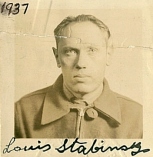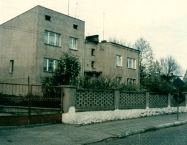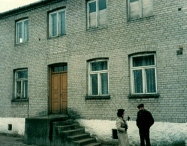|
|
|
|

|
|
1937 Passport Photo
Louis Stabinsky
(Yitzhak Leibl Sztabinski) |
|
| |
|
In 1985, I asked my father, Louis
Stabinsky, who was then 86 years old, if he would accompany my wife and me on a
trip to his birthplace, Radzilow. He left there in 1921. At first he agreed to
come and then, upon reflection, refused and said, "You don't know what those
killers will do. They will keep you there. No, I won't go and I don't want you
to go, either." He implored my older brother to try to influence me against such
a trip. I responded that I wanted to see where my father lived and grew up, not
where his whole family was murdered.
I arranged to hire an English speaking
guide in Warsaw and we spent a day visiting Radzilow and my mother's birthplace, Makow Mazowiecki.
As we entered Radzilow, after lunch in
Lomza and driving through Jedwabne, we passed a little bridge and I told the
driver to stop. I said to my wife, Char, that that building must be my uncle,
Chaim Eli's mill. A farmer was in his yard across from the mill and I asked him
who owned the mill. He told me the government owned everything. It was still
Communist time. I asked, "Who owned the mill before?" He told me that he owned
it and had bought it from the Jew who went to Israel. That was my uncle's
partner. He left out that my uncles, aunts, cousins, grandparents were all
murdered in the town square.
|
|
|
 |
 |
Site where Louis Stabinsky (Yitzhak Leibl Sztabinski)
lived on Karwowska St. |
|
|
| |
|
Since my father had described the town
and drawn a map of the town, we then went to the site where he had lived. A
substantial stucco building which apparently housed school teachers was on the
property now.
But right next door was a hovel that reminded me of Tevya's house in
Fiddler on the Roof. An old woman peered out the window and we beckoned her to
come out. I stood nose to nose with her and said, "Sztabinski." She responded,
"Yitzhak (my father), Rifka (an aunt), Raisel (another aunt)." The woman
was 82, had grown up in the house next to my grandparents and their children,
played with them and told me she went to the wedding of one of my aunts. She
started to say the few Yiddish words that she learned in the house next to hers.
She was as moved emotionally by meeting me as I was to meet her.
The trip that I took to walk on the same
ground as my father and just to look
at the land where he grew up turned into a dynamic experience when I met someone
who played as a child with my father and his siblings.
|